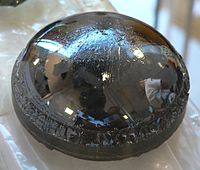
Photo from wikipedia
In magnetorheological fluid-based finishing processes, the lower gripping of abrasives in between ferromagnetic particle’s chain structure limits its finishing speed, resulting in a lower material removal rate and desired surface… Click to show full abstract
In magnetorheological fluid-based finishing processes, the lower gripping of abrasives in between ferromagnetic particle’s chain structure limits its finishing speed, resulting in a lower material removal rate and desired surface standard. In addition, tool ageing has significantly impacted these finishing processes at a higher speed. To improve the efficiency of finishing processes, composite magnetic abrasives are fabricated by using powder metallurgy techniques via both microwave and conventional processing (sintering) routes. Comparison studies were performed on these samples based on ferromagnetic materials (CIPs and EIPs) used and sintering at 950°C under fixed element composition. A newly advanced chemo-mechanical magneto-rheological finishing (CMMRF) process for aluminium alloy surface polishing was also proposed, combining mechanical abrasion and chemical action for the performance evaluation of composite magnetic abrasives. Most notably, the microwave processed composite magnetic abrasive outperformed conventionally processed samples in terms of magnetic and rheological properties. The composite magnetic abrasives significantly increased the rate of material removal from the metal surface while reducing the tool ageing effect. The surface profile and observation show that a nearly defect-free surface was produced at higher speeds using these composite magnetic abrasives compared to simply mixed abrasives based results.
Journal Title: Proceedings of the Institution of Mechanical Engineers, Part C: Journal of Mechanical Engineering Science
Year Published: 2022
Link to full text (if available)
Share on Social Media: Sign Up to like & get
recommendations!